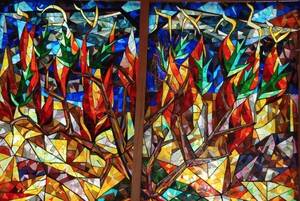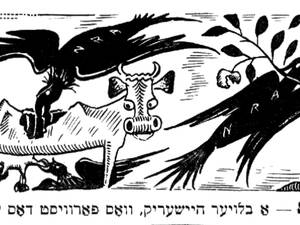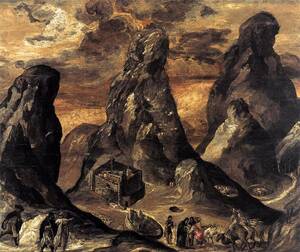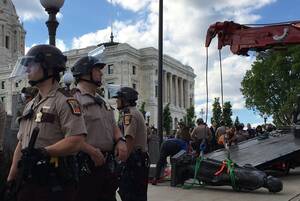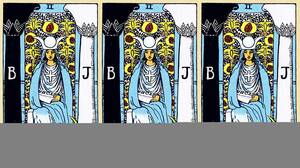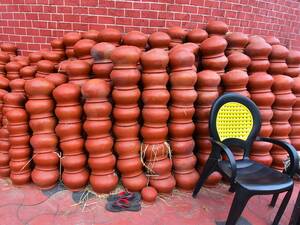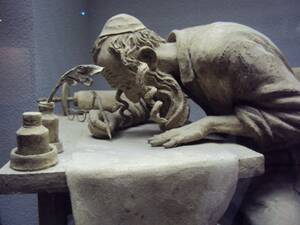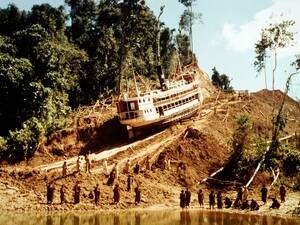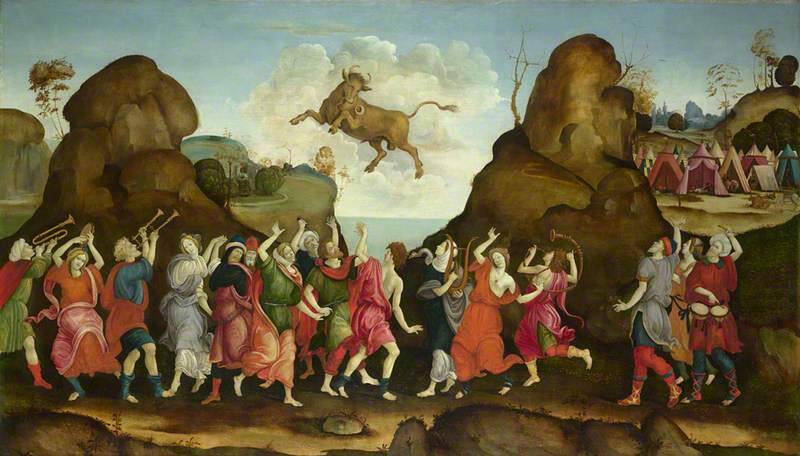
Read previous entries of Slow Burn: Quarantine Edition here.
Ki Tissa
Exodus 30:11 – 34:35
Brooklyn, NY
Dear Redemption Seekers,
Early most mornings, I perch at the edge of my bed, wrapped in tallit and tefillin, whispering repetitive prayers. For me, the declarations that fill Jewish prayer can feel like backhanded acknowledgements of my own—and G-d’s—deficiencies. What’s the point of constantly reiterating that I’m full of love and wonder unless I’m actually bitter and impatient? Would a deity need to be reminded that They were just and compassionate, if They weren’t really rash and jealous? To me, the meaning of prayer emerges precisely in this tension. The daily act of binding my flawed, troubled self—literally, with straps of leather—to a jealous G-d, while babbling about how good we both are, points us both toward how we might come to fulfill the words I whisper. Because 5781 is upon us, as I pray, I’ve been consumed with reflections on how I behaved over the past year—how my actions fell short of my aspirations, and how I can make amends.
Ki Tissa, the ninth parsha of Exodus, is a dramatic tale of transgression and forgiveness. In the dry preceding sections, Moses and the Israelites become almost imperceptible, fading out between the desert and, as Sarah put it in her letter, “lines and lines of civic code.” The eruption of drama in Ki Tissa snaps these figures into focus. We are thrown into the midst of a revolt, a rageful leader, and a jealous G-d. “Quick,” G-d says to Moses in Robert Alter’s translation, after giving him the tablets of the law, “go down, for your people that I brought up from Egypt has acted ruinously . . . now leave Me be, that My wrath may flare against them, and I will put an end to them.” Moses, with cunning rhetoric and compassion, bargains for the Israelites’ lives and hurries down Sinai, carrying the tablets with him. But his people are no longer waiting for him to return. Instead they are writhing in an orgy of worship, not of G-d but of an idol—the Golden Calf. Witnessing their wickedness, Moses becomes enraged. He hurls the tablets, shattering them.
A bitter power struggle follows. Moses enlists the Levites—one of the 12 tribes, which later becomes the priestly caste—to slaughter those who will not accept G-d; 3,000 Israelites perish. G-d, meanwhile, sends a plague upon the Israelites, one left ominously underexplained by the text. Amid the cacophony of conflict, there seems to be no remorse, no change, only waves of punishment, until G-d, through Moses, announces that because the Israelites are so “stiff-necked” and infuriating, G-d will be leaving their midst. The Israelites—maybe scared, maybe tired of G-d’s punishments, maybe genuinely remorseful—begin to mourn.
This shift in the Israelites’ response seems to create the opening for a reckoning between them and G-d. Moses returns to his negotiations—this time not on Sinai, but in a “Tent of Meeting” he pitches outside the Israelites’ camp—where G-d now “speak[s] to Moses face to face, as a man speaks to his fellow.” Something in the relationship has changed. Moses pleads with G-d to forgive the Israelites for their transgression, and to restore their status as G-d’s chosen people. His appeal—in which he calls G-d “compassionate and gracious . . . slow to anger, and abounding in kindness and good faith”—resonates strangely following G-d’s display of rage. But perhaps, like my own prayers, these claims point toward a hope for the future. G-d agrees to take the Israelites back, and Moses returns to Sinai to receive the law again, where he lingers, fasting, for 40 days and 40 nights. The first time around, G-d had presented Moses with the commandments in the form of “tablets of stone written by [G-d’s own] finger.” This time, by contrast, the Lord has Moses etch a new set of tablets himself. Thus, G-d “seal[s] a covenant.”
According to later rabbinic calculations, these monumental events—G-d’s decision to forgive the people, and the people’s entry into the new covenant carved into stone by their leader—happened on the tenth day of the month of Tishrei. It was the first Yom Kippur.
IT WAS IN Midrash Tanhuma, a collection of biblical interpretations composed sometime between the 5th and 7th centuries, that the rabbis of antiquity mapped some of the key plot points of Exodus onto the Jewish calendar. They stretched this narrative over 120 days, with Moses’s return to Sinai in Ki Tissa spanning the end of one year and the beginning of the next. In the Middle Ages, Rashi, author of expansive commentaries on Torah and the Talmud, distilled this timeline:
On 7 Sivan, Moses went up onto the mountain . . . On 17 Tammuz, the tablets were broken. On the 18th, he burned the [Golden] Calf and judged the transgressors. On the 19th, he went up for forty days and pleaded for mercy. On 1 Elul, he went up to receive the second tablets, and was there for forty days. On 10 Tishrei, G-d restored His goodwill with the Jewish people gladly and wholeheartedly, saying to Moses, “I have forgiven, as you ask,” and gave him the Second Tablets.
This entwining of biblical narrative and cyclical time persists today, giving the Jewish calendar’s final and initial months their sacred meaning. We are now in the ten-day period between Rosh Hashanah and Yom Kippur known as the Days of Awe. Observant Jews consider this interval to be the holiest time of the year. It is the period when the gates of heaven are open, and we make “teshuva”—repent—while G-d listens and passes judgment. Just as G-d “restored His goodwill” on the tenth of Tishrei in Moses’s time, G-d now reconciles with the people every year on Yom Kippur.
The association of this holy time with the narrative of Ki Tissa suggests that we can turn to G-d’s forgiveness of the Israelites as a model for how to understand teshuva. The biblical events make clear that for Jews, divine forgiveness is a hard bargain, far from the Christian paradigm of radical acceptance. The Israelites have already suffered thousands of deaths and endured a plague as a consequence for their wickedness. Teshuva arises from their heartbreak, their brokenness.
This is the apologetic presented by Ki Tissa, which boldly suggests that the destruction of G-d’s word, and its recreation by humankind, were necessary for the establishment of the Jewish paradigm of teshuva and forgiveness. This transformation requires the first set of tablets, the ones G-d writes with His finger, to be irrevocably destroyed, and for Moses to inscribe the replacement stone himself. Near the end of his life, the Lubavitcher Rebbe Menachem Schneerson reflected on Ki Tissa. “[T]he second tablets were, in fact, superior, for they contained the Oral Torah, providing the means to rectify the breaking of the first tablets,” writes Elliot R. Wolfson, a scholar of Hassidus, paraphrasing Schneerson’s view. “By means of the second tablets, Moses merited to comprehend the inner and essential wisdom of the Torah that was even higher than the revelation of the first tablets.” While the original tablets were decrees from on high—as Jacob discussed, Rav Admi bar Chama understood them as having been accepted only under duress—the new tablets, written by Moses, are bound to the Israelites by the actions of their leader. This renegotiation is all the more sacred when seen as the resolution to a series of events that surfaced both the strength and weaknesses of both G-d and the Israelites: their impatience and jealousy, power and cunning. But they have still made the decision to share a world.
When we practice teshuva, then, we are like Moses inscribing the words of G-d in our own hand; teshuva, after all, literally means “return.” According to the understanding of atonement offered by Ki Tissa, it takes destruction and rebellion for us to be able to enter into a new pact, a more human one, in which we stop hiding our flaws and seek repair. As Briallen asked in her letter, have we all, in this moment of interlocking and escalating crises, arrived at a time when the shadow of bondage can be cast off, and the shattered world around us refused and remade?
Carina provocatively described the events of Ki Tissa as “the Riot of the Golden Calf,” celebrating the Israelites’ rejection of an absent leader and an invisible G-d for a tangible idol, which “demands and manifests divine presence through collective action.” In her reading, the Tabernacle—and thus the law—embodies G-d’s “effort to placate and institutionalize the riot’s energy.” I found this interpretation fascinating and generative. But I think there’s also a radical lesson to be found in the second set of tablets, in the transformation of the law that follows the riot. To me, the radical potency of the Golden Calf emerges not in its construction, but in the power struggle it ignites, which embodies the fundamental struggle to live with the weight of our actions, to repair ourselves and account for the harm we cause. This conflict lives on in the reinscribed law, and in the endless work of teshuva that allows for the creation and endless recreation of a covenant between G-d and people as they actually are. Teshuva is the bridge between the ideal world, shattered at our feet, and the world that is, where we must toil—but in which lives the irrepressible possibility of redemption.
G’mar chatima tova,
Isaac
Isaac Brosilow is a contributing writer for Jewish Currents and an independent researcher from Chicago, currently based in Brooklyn. His work has appeared in Protocols and Graylit.

